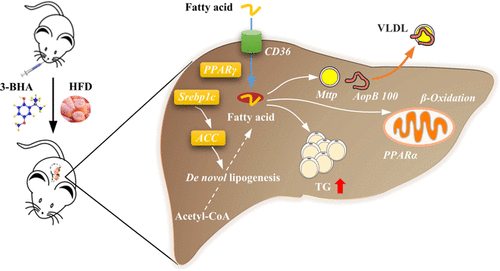当前位置:
X-MOL 学术
›
Environ. Sci. Technol.
›
论文详情
Our official English website, www.x-mol.net, welcomes your
feedback! (Note: you will need to create a separate account there.)
3-tert-Butyl-4-hydroxyanisole Impairs Hepatic Lipid Metabolism in Male Mice Fed with a High-Fat Diet
Environmental Science & Technology ( IF 10.8 ) Pub Date : 2022-02-08 , DOI: 10.1021/acs.est.1c07182 Zhendong Sun 1, 2 , Zhi Tang 3 , Xiaoxi Yang 2 , Qian S Liu 2 , Jianqing Zhang 4 , Qunfang Zhou 1, 2 , Guibin Jiang 1, 2
Environmental Science & Technology ( IF 10.8 ) Pub Date : 2022-02-08 , DOI: 10.1021/acs.est.1c07182 Zhendong Sun 1, 2 , Zhi Tang 3 , Xiaoxi Yang 2 , Qian S Liu 2 , Jianqing Zhang 4 , Qunfang Zhou 1, 2 , Guibin Jiang 1, 2
Affiliation

|
3-tert-Butyl-4-hydroxyanisole (3-BHA), one of the widely used food antioxidants, has been found to act as a potential obesogen by promoting adipogenesis in vitro and inducing white adipose tissue development in vivo. Whether 3-BHA-induced visceral obesity was accompanied by a disruption of hepatic lipid homeostasis in mammals remained unclear. In this study, we evaluated the effect of 3-BHA on the development of nonalcoholic fatty liver disease (NAFLD) in male C57BL/6J mice. After 18 weeks of oral administration of 10 mg/kg 3-BHA, the mice fed with a high-fat diet (HFD) had higher hepatic triglyceride concentrations (0.32 mg/mg protein) and severer steatosis (1.57 for the NAFLD score) than the control ones. The in vivo hepatic lipid deposition disturbed by 3-BHA was transcriptionally regulated by the genes involved in lipid uptake, de novo lipogenesis, fatty acid oxidation, and lipid export. The in vitro studies further confirmed that 24 h of exposure to 50 μM 3-BHA could induce intracellular oleic acid (OA) uptake and triglyceride accumulation (1.5-fold of the OA control) in HepG2 cells. Lipidomic analysis indicated the perturbation of 3-BHA in the levels of 30 lipid species related to sphingolipids, glycerophospholipids, and glycerolipids under HFD conditions. The findings herein first revealed the disruption effect of 3-BHA on hepatic lipid homeostasis, thus exacerbating the development of HFD-induced NAFLD.
中文翻译:

3-叔丁基-4-羟基茴香醚损害高脂饮食雄性小鼠的肝脂质代谢
3-叔丁基-4-羟基茴香醚 (3-BHA) 是一种广泛使用的食品抗氧化剂,已被发现通过在体外促进脂肪生成和在体内诱导白色脂肪组织发育而成为潜在的肥胖原。哺乳动物中 3-BHA 诱导的内脏肥胖是否伴有肝脏脂质稳态的破坏仍不清楚。在这项研究中,我们评估了 3-BHA 对雄性 C57BL/6J 小鼠非酒精性脂肪肝 (NAFLD) 发展的影响。口服 10 mg/kg 3-BHA 18 周后,喂食高脂饮食 (HFD) 的小鼠肝脏甘油三酯浓度 (0.32 mg/mg 蛋白质) 和更严重的脂肪变性 (NAFLD 评分为 1.57)控制的。体内_受 3-BHA 干扰的肝脏脂质沉积受涉及脂质摄取、从头脂肪生成、脂肪酸氧化和脂质输出的基因转录调控。体外研究进一步证实,暴露于 50 μM 3-BHA 24 小时可诱导 HepG2 细胞中的细胞内油酸 (OA) 摄取和甘油三酯积累(OA 对照的 1.5 倍)。脂质组学分析表明,在 HFD 条件下,3-BHA 对 30 种与鞘脂、甘油磷脂和甘油脂相关的脂质种类的水平产生了干扰。本文的研究结果首次揭示了 3-BHA 对肝脏脂质稳态的破坏作用,从而加剧了 HFD 诱导的 NAFLD 的发展。
更新日期:2022-02-08
中文翻译:

3-叔丁基-4-羟基茴香醚损害高脂饮食雄性小鼠的肝脂质代谢
3-叔丁基-4-羟基茴香醚 (3-BHA) 是一种广泛使用的食品抗氧化剂,已被发现通过在体外促进脂肪生成和在体内诱导白色脂肪组织发育而成为潜在的肥胖原。哺乳动物中 3-BHA 诱导的内脏肥胖是否伴有肝脏脂质稳态的破坏仍不清楚。在这项研究中,我们评估了 3-BHA 对雄性 C57BL/6J 小鼠非酒精性脂肪肝 (NAFLD) 发展的影响。口服 10 mg/kg 3-BHA 18 周后,喂食高脂饮食 (HFD) 的小鼠肝脏甘油三酯浓度 (0.32 mg/mg 蛋白质) 和更严重的脂肪变性 (NAFLD 评分为 1.57)控制的。体内_受 3-BHA 干扰的肝脏脂质沉积受涉及脂质摄取、从头脂肪生成、脂肪酸氧化和脂质输出的基因转录调控。体外研究进一步证实,暴露于 50 μM 3-BHA 24 小时可诱导 HepG2 细胞中的细胞内油酸 (OA) 摄取和甘油三酯积累(OA 对照的 1.5 倍)。脂质组学分析表明,在 HFD 条件下,3-BHA 对 30 种与鞘脂、甘油磷脂和甘油脂相关的脂质种类的水平产生了干扰。本文的研究结果首次揭示了 3-BHA 对肝脏脂质稳态的破坏作用,从而加剧了 HFD 诱导的 NAFLD 的发展。































 京公网安备 11010802027423号
京公网安备 11010802027423号